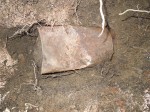 A couple walking the dog on their property in Northern California last spring discovered the biggest and most valuable gold coin hoard ever unearthed in the United States. They were treading the same well-worn path they’ve trod hundreds of times for the dog’s daily constitutional when they spotted the rusted top of a metal can sticking up out of the eroded ground. They dug the can out with a stick and took it home.
A couple walking the dog on their property in Northern California last spring discovered the biggest and most valuable gold coin hoard ever unearthed in the United States. They were treading the same well-worn path they’ve trod hundreds of times for the dog’s daily constitutional when they spotted the rusted top of a metal can sticking up out of the eroded ground. They dug the can out with a stick and took it home.
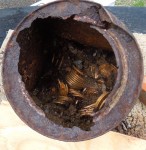 It was so heavy lugging it back proved to be quite an effort. They figured there was lead paint inside. When the lid cracked off the husband saw the seductive rib of a single gold coin. Clearing out the rest of the contents, they found a lot of dirt and a stack of $20 liberty head gold coins from the 1890s. The pair promptly returned to the find spot, an area they dubbed Saddle Ridge, and dug some more. They immediately found another can about a foot to the left of where they had found the first can. Then they found five more smaller cans, and one last can they used a metal detector to locate.
It was so heavy lugging it back proved to be quite an effort. They figured there was lead paint inside. When the lid cracked off the husband saw the seductive rib of a single gold coin. Clearing out the rest of the contents, they found a lot of dirt and a stack of $20 liberty head gold coins from the 1890s. The pair promptly returned to the find spot, an area they dubbed Saddle Ridge, and dug some more. They immediately found another can about a foot to the left of where they had found the first can. Then they found five more smaller cans, and one last can they used a metal detector to locate.
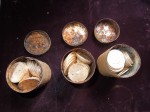 The eight cans contained a total of 1,427 gold coins. Most of them, 1,373, to be precise, were $20 coins, 50 were $10 coins and four were $5 coins. Most were minted in San Francisco; one of the $5 coins was minted in Georgia. They date to between 1847 and 1894 and were stacked in approximate chronological order; all the 1840s and 50s coins in the first can and the rest by date in subsequent cans. The arrangement of coins and the varying condition of the cans suggest they were buried by someone over the course of years rather than the result of a single caper like a bank robbery. The total face value of the coins is $27,980.
The eight cans contained a total of 1,427 gold coins. Most of them, 1,373, to be precise, were $20 coins, 50 were $10 coins and four were $5 coins. Most were minted in San Francisco; one of the $5 coins was minted in Georgia. They date to between 1847 and 1894 and were stacked in approximate chronological order; all the 1840s and 50s coins in the first can and the rest by date in subsequent cans. The arrangement of coins and the varying condition of the cans suggest they were buried by someone over the course of years rather than the result of a single caper like a bank robbery. The total face value of the coins is $27,980.
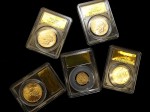 In a panic over what to do with the immense gold treasure they had just found walking the dog, the owners took a page out of the original hoarder’s book. They put the coins in plastic bags and the bags inside an old cooler. They then dug a hole under the wood pile buried the cooler there. Two months later, they invited coin dealer Don Kagin and numismatic expert David McCarthy of Kagin’s, Inc. to examine the hoard. They found an incredible wealth of rare coins in beautiful condition. Fully thirteen of them are either the finest examples known to exist or tied for the finest. One of them, an 1866-S No Motto Double Eagle, is estimated to be worth $1 million on its own.
In a panic over what to do with the immense gold treasure they had just found walking the dog, the owners took a page out of the original hoarder’s book. They put the coins in plastic bags and the bags inside an old cooler. They then dug a hole under the wood pile buried the cooler there. Two months later, they invited coin dealer Don Kagin and numismatic expert David McCarthy of Kagin’s, Inc. to examine the hoard. They found an incredible wealth of rare coins in beautiful condition. Fully thirteen of them are either the finest examples known to exist or tied for the finest. One of them, an 1866-S No Motto Double Eagle, is estimated to be worth $1 million on its own.
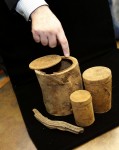 It’s fitting that such a rich find would be made in Gold Country, the region of the Sierra Nevadas east of Sacramento to the Nevada state line where an 1848 gold strike at Sutter’s Mill set off the madness of the California Gold Rush. Someone in the area was bucking the trend and putting gold back into the ground, oftentimes before it had even circulated. Many of the Saddle Ridge Hoard coins are in near-perfect condition, even the older ones. Paper money wasn’t legal in California until the 1870s, which means most of the coins from before then saw a great deal of circulation and wear. People didn’t start keeping California gold coins in uncirculated condition until the 1880s.
It’s fitting that such a rich find would be made in Gold Country, the region of the Sierra Nevadas east of Sacramento to the Nevada state line where an 1848 gold strike at Sutter’s Mill set off the madness of the California Gold Rush. Someone in the area was bucking the trend and putting gold back into the ground, oftentimes before it had even circulated. Many of the Saddle Ridge Hoard coins are in near-perfect condition, even the older ones. Paper money wasn’t legal in California until the 1870s, which means most of the coins from before then saw a great deal of circulation and wear. People didn’t start keeping California gold coins in uncirculated condition until the 1880s.
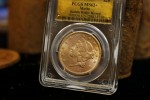 The exceptional condition and rarity of the coins makes their estimated market value around $10 million, far exceeding the estimated $1 million value of the other contender for biggest gold hoard found buried in the United States. The Tennessee Hoard was found in Jackson by workers building a city parking lot in 1985. The exact quantities found are not known because the workers pocketed much of the coins before the site was protected. Judging from the assessment of gold dealers who bought most of the Tennessee coins, there were hundreds totaling about $4,500 in face value and while the condition of some pieces was excellent, many of them were damaged by heavy machinery during the discovery while others were cleaned so roughly the coin surface was cracked.
The exceptional condition and rarity of the coins makes their estimated market value around $10 million, far exceeding the estimated $1 million value of the other contender for biggest gold hoard found buried in the United States. The Tennessee Hoard was found in Jackson by workers building a city parking lot in 1985. The exact quantities found are not known because the workers pocketed much of the coins before the site was protected. Judging from the assessment of gold dealers who bought most of the Tennessee coins, there were hundreds totaling about $4,500 in face value and while the condition of some pieces was excellent, many of them were damaged by heavy machinery during the discovery while others were cleaned so roughly the coin surface was cracked.
The couple has chosen to remain anonymous and keep their exact location secret to avoid turning their peaceful rural home into Sutter’s Mill 2: Now We Have Metal Detectors. They plan to sell 90% of the coins in a landmark deal with Amazon’s new Collectibles & Fine Art store. This is the first coin treasure to be sold via Amazon. Most of the rest will be sold privately directly to collectors. The couple plans to keep a small selection of the hoard. As “John” says in this great interview with the finders “Mary” and “John” on the Kagin’s website, “We would like to hold onto a cross section of it – something to leave to relatives when we pass on.”
I love their response to the question about whether they had noticed anything unusual about the find spot before:
John: Years ago, on our first hike, we noticed an old tree growing into the hill. It had an empty rusty can hanging from it that the tree had grown around – that was right at the site where we found the coins… At the time we thought the can might be a place for someone to put flowers in for a gravesite – something which would have been typical at the time.
There was also an unusual angular rock up the hill from where the coins were buried – we’d wondered what in the heck it was.
Mary: It wasn’t until we made the find that we realized it might have been a marker: starting at the rock, if you walk 10 paces towards the North Star, you wind up smack in the middle of the coins!